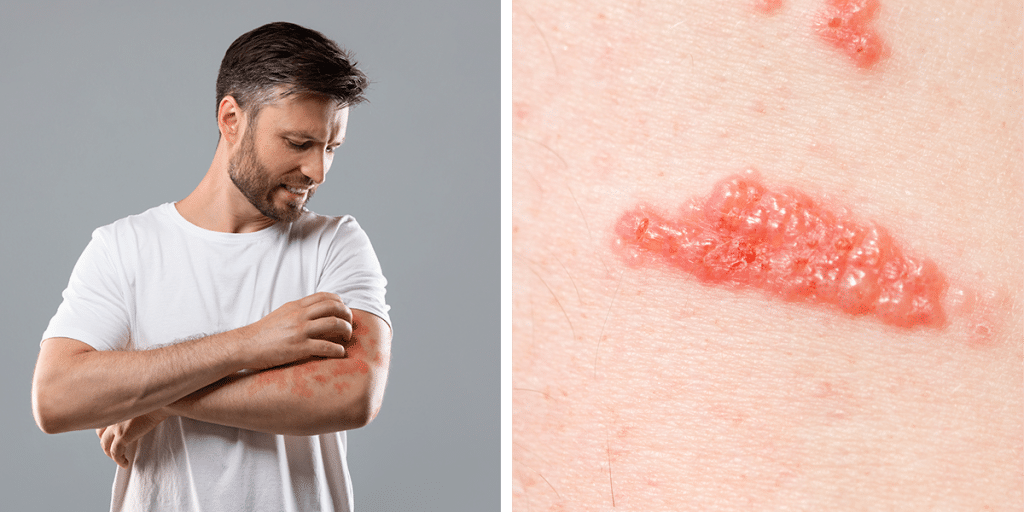If you’re a Facebook user, chances are you’ve seen a post like this in your feed, “Hey y’all, can you look at this picture of my kid’s arm and tell me if this is poison ivy rash or eczema?” The post includes a photo of a rash that looks like it belongs in a science textbook or at the emergency room.
Yikes! No need to post to your social media page. We’re talking about poison ivy, poison oak and poison sumac rashes. Hopefully, today you’ll be able to tell the difference between poison ivy rash and other types of skin irritation.
What are Poison Ivy, Poison Oak and Poison Sumac?
Poison ivy, poison oak and poison sumac are three plants native to North America that can cause severe skin irritation. Many are familiar with the unpleasant rashes but don’t know about the plants.
Clearly, we’re not horticulture experts at Integrity Urgent Care, but because poison ivy and related plants are among the most common summer skin irritants, learning to avoid the plants themselves is the first step to rash prevention. Unfortunately, poison ivy, poison oak, and poison sumac all grow in Texas – so our patients need to know how to identify poison ivy and its friends.

Identify Poison Ivy Plant
Poison ivy is a plant that grows in climates across the continent. It can grow as both a shrub and a vine. It’s found in pastures, home landscapes, woodlands, fields and farms. It can wind up structures using its roots when growing in vine form. You may have heard the saying, “leaves of three, let it be,” which is true for poison ivy. To identify poison ivy, look for clusters of three leaves. Some poison ivy plants also produce small, waxy white fruit.
Identify Poison Oak Plant
Poison oak is very similar to poison ivy, and the leaves grow in clusters of three, but it is a distinct plant species. It can grow in many different environments but usually only at elevations below 5,000 feet. Other differences between poison ivy and poison oak are poison oak’s “hair” on the top and bottom of the leaves, it grows in bushes (not vines), and the leaves are shaped similarly to oak tree leaves. Additionally, poison oak’s fruit is tan instead of white.
Identify Poison Sumac Plant
“Leaves of three, let it be” does not apply to poison sumac. So, what does poison sumac look like? Poison sumac is a shrub with slender red stems and a leaf at the end of each branch. The leaves grow in groups of 7-13. The plants are deceptive because their leaves turn vivid shades of red, orange and pink in the fall and are enticing for picking or touching. Similar to poison ivy and poison oak, the entire plant is poisonous. So even in winter, after the plant has lost its leaves, you can still develop a rash from contact with the stem.
Why Does Poison Ivy Cause a Rash? Poison Oak and Sumac, Too?
The entire poison ivy plant (as well as poison oak and poison sumac) is considered poisonous because all parts contain an oil called urushiol. This oil is released from the plant when the leaves or stems are touched, bruised, or burned. Because it’s an oil, it’s sticky and easily transferred from one surface to another.
How Do You Get a Poison Ivy Rash?
Common ways to come into contact with poison ivy and related plants–resulting in a rash–include:
- Touching the plant – stems, leaves, or fruit
- Touching an object that was in direct contact with the plant, like garden tools or clothing
- Coming into contact with a pet who has touched the plant and then transferred the oil to you or another surface in your home
- Inhaling smoke from a burning plant, unfortunately, smoke containing the oil can irritate your nose, lungs and respiratory tract

When you participate in the following activities, you increase your risk of poison ivy rash or poison oak rash:
- Camping
- Landscaping
- Farming
- Clearing brush or debris
- Forestry
- Hiking
- Hunting
What Does a Poison Oak, Ivy or Sumac Rash Look Like?
Rashes caused by urushiol all have a few main indicators. If you have a rash with these distinguishing characteristics, you may be experiencing a poison ivy rash (or a rash from its urushiol-containing relatives).
Poison Ivy Symptoms
- Swelling
- Red rash within a few days of contact
- Itching
- Bumps, red patches or streaking, or weeping blisters (The fluids in blisters will not cause blisters to spread on you or others. So while a little yucky, they are not contagious.)
- If the oil is inhaled, you may experience trouble breathing
Poison Ivy Rash Shape or Formation
Sometimes the rash appears in a straight line because your skin brushed against the plant. However, if the oil was transferred to you from clothing or a pet, it can appear in a more spread-out formation.
Unfortunately, you can spread the oil with your fingers. If you scratch or touch an area where the oil remains, it can spread to anywhere else you touch. Once the oil has been thoroughly washed off of your skin and hands, it will not continue to spread unless you come into contact with the oil again. (For example, hugging your dog who rolled in poison sumac on your walk.)

How Can I Prevent Getting Poison Ivy Rash?
There are a few ways to prevent a poison ivy, oak or sumac rash.
- Avoid plants containing urushiol
- Wear long, protective clothing when working outside or visiting a wooded area
- Remove the plants if you see them growing (do not burn them, though)
- Wash your hands and skin immediately after potentially touching poison ivy
- Wash your pets’ fur regularly
- Clean contaminated objects, or objects at high risk of contamination, like garden tools
If you have had exposure to poison ivy, take these steps immediately to remove the oil from your skin and, hopefully, stop the poison ivy symptoms from occurring.
- Rinse your skin right away
- Use rubbing (isopropyl) alcohol, degreasing soap (like Dawn) or detergent, and lots of water
- Rinse your skin repeatedly to try to prevent the oil from soaking into your skin or spreading
- To ensure you don’t spread the oil by scratching, scrub under your fingernails with a brush and degreasing dish soap
How to treat poison oak, poison sumac and poison ivy
If you develop a mild rash on your skin that meets the described symptoms of poison ivy rash, you can treat it at home. If your inflammation and symptoms are mild, it may not require a visit to the doctor. Recommended at-home treatment for mild poison ivy rash:
- Apply a wet compress, calamine lotion or hydrocortisone cream. This will help reduce swelling, itchiness and stinging
- Be sure to follow the instructions for creams, and don’t apply them to open blisters
- Take an oatmeal bath to reduce irritation
- Take an antihistamine such as diphenhydramine (like Benadryl) to help relieve itching.
When to see a doctor for poison ivy or poison oak rash
If you have a reaction causing you difficulty breathing, you should visit the Emergency Room or dial 911.
If your symptoms become severe but are not life-threatening, you should seek help from a medical professional. The team at Integrity Urgent Care sees patients with non-life-threatening illnesses and injuries across Texas seven days a week. We’re happy to help with your poison ivy, poison oak or poison sumac rash treatment.
If your reaction includes the following severe symptoms, you should seek medical help.
- Severe and widespread
- On your face, eyes or genitals
- Swells continually and not slowing
- Blisters are oozing, open and appear infected
- You develop a fever greater than 100F
- The rash does not improve after a week or more
Contact Integrity Urgent Care today to schedule an appointment with our team at the location that is closest to you.


